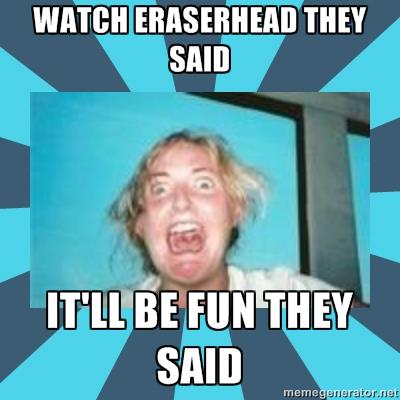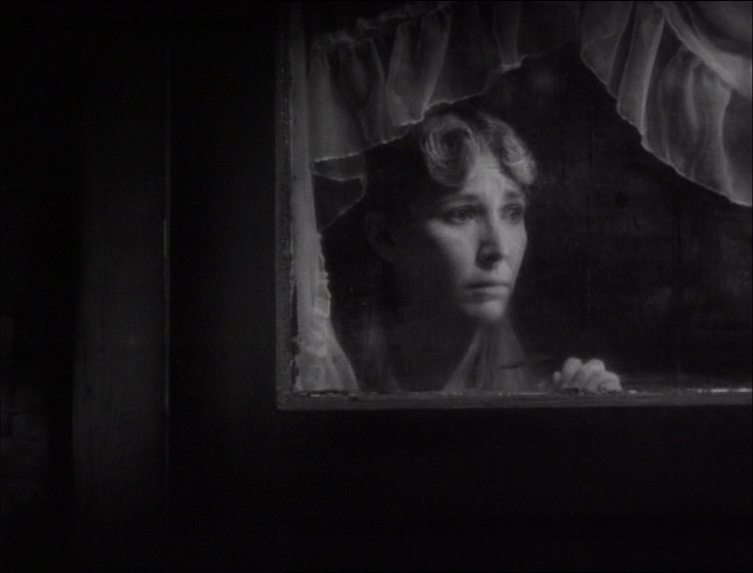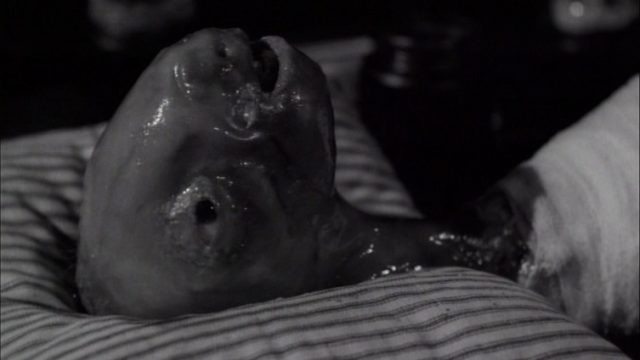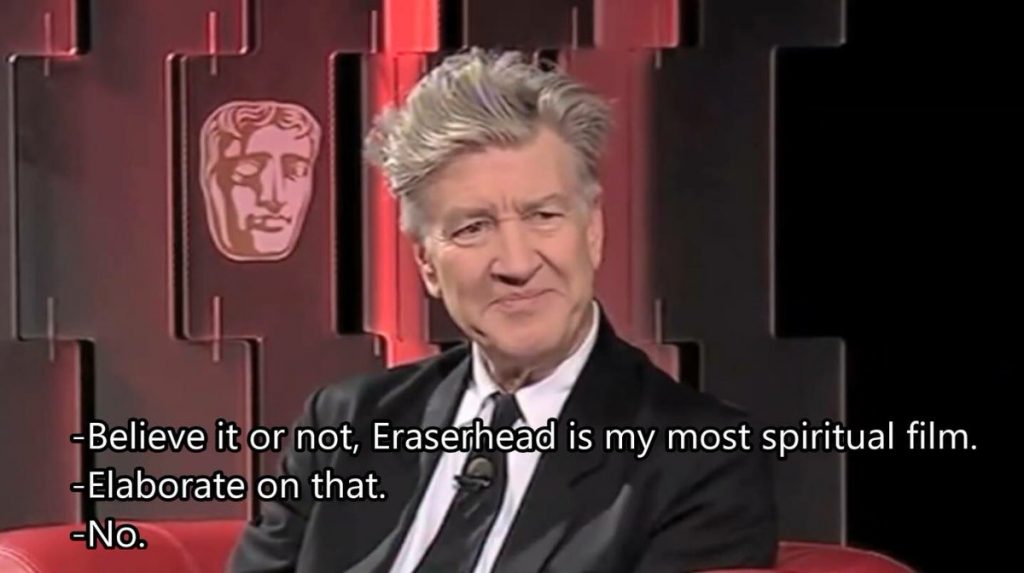Listen: Ron Burgundy has come unstuck in time.
It’s autumn, 2012. I’m lying on a bed in a dorm room in Tennessee across from my roommate’s life-sized poster of himself. I’m watching Eraserhead on a laptop, on Hulu — they still have access to the Criterion Collection.
It’s 1970. David Lynch comes up with a story about Henry, a man struggling with his horrible nightmare baby (“They’re still not sure it is a baby!”) in a horrible nightmare world, based on his actual dreams and daydreams. He begins living in an abandoned stable that’s also his film set.
It’s 2011. I’m in a small town in Montana, David Lynch’s birthplace. I’d always loved movies, but now I’m beginning to take them seriously. I’m especially interested in the German Expressionists, because I know they’re the ancestors of Tim Burton, one of the few filmmakers I’d already studied seriously. And I’m interested in anyone who exists on that wavelength, somewhere between my newfound interests for horror and classier fare — shadowy movies, often black and white, often low-budget, about other worlds. I’m starting to think I should check out Eraserhead. I read it compared to those other filmmakers, especially to Metropolis. It seems like a safe bet.
It’s 1972. David Lynch moves into an abandoned stable, which is also his film set.
It’s 2012. It wasn’t a safe bet. I was already learning to enjoy horror movies, but this isn’t that. This is a true nightmare, and I just want to wake up. We all know horror movies are thrill rides, but this doesn’t have the cathartic payoff and adrenaline rush. It’s just that sickening dread as you go up, up, up, and never come down. And I hate it. Rest assured, I am on the internet within minutes (well, days) registering my disgust throughout the world (well, throughout my Facebook friends).

It’s 1976. David Lynch is still working on Eraserhead.
It’s October 26th, 2018. I’m back in Montana again. I’m watching Eraserhead again.
It’s July 16th, 2015 (thank God for Letterboxd for giving me the specific dates so I can make this bit work). I’m in Crazy Mike’s, my hometown video store, may it rest in peace. After years avoiding Lynch, I dip my toe back in the water. I play it safe — I start with The Straight Story. Not just because a PG-rated Disney movie isn’t likely to traumatize me like Eraserhead did, but because I just had to know what the fuck a David Lynch Disney movie would be like. I love it.
It’s 1977. David Lynch is finally showing Eraserhead. It still isn’t finished.
It’s August 16th, 2015. I’m watching Mulholland Drive. It’s my mom’s idea, but I love it even more.
On October 26th, 2018, after all that, I’ve overcome my Lynch-ophobia. I’ve seen all his major movies, two in the theater, and most of Twin Peaks, even The Missing Pieces. I posted on Twin Peaks Logposting for fuck’s sake. And I keep going back because I want that sickening nightmare feeling, that pure Lynchian terror. And I keep going back more than I do to other filmmakers I like more because I rarely get more than a glimpse of it. I always feel like he’s holding back. And I remember Eraserhead. I think maybe this time I’ll be on its wavelength.
I’m not. Everything that kept me unwillingly under its spell the first time does nothing at all. I see the images that horrified me so much, and they’re just images — random, disconnected, and held on for way too long. How can the same movie be so different at different times?
It’s November, 2020. I’m planning on what Years of the Month to do next year. I set aside 1977 for May. I look at what came out that year, I see Eraserhead, and I think of that question again. Well, I think I have to write something about that.
It’s May 13th, 2021, maybe later. You’re reading something about that.
It’s May 11th, 2021. I’m in North Carolina. I watch Eraserhead again, finally on a real TV, hoping that this time I’ll thread that needle between getting hurt by the movie and not feeling anything at all. This is the third time I’ve seen it. I’ve hardly watched any movie I loved immediately that much. Maybe this time I’ll get it.
I do, more or less.
In 2012, I’m still developing my sense of what makes a good movie. I know great art provokes emotions. But I’m still influenced by my family, who don’t like horror and use “depressing” as a negative. So what do you do with great art that provokes emotions you don’t want to feel? I apply this to, of all things, my childhood VHS tape of Bambi while I’m rewatching it. All that great artistry going into sickening cuteness — is it still great art?
Eraserhead’s about as far as you can get from that, but it provokes such a violently negative reaction I have no problem putting it in the “bad” column for how it makes me feel no matter how skillfully it manipulates me.
But you know what? I like sickening dread. It’s the main ingredient in some of the best horror movies — The Texas Chain Saw Massacre, Beyond the Black Rainbow, The Neon Demon, Videodrome, Society, The Babadook, which I even went back to that roller coaster metaphor for. And Lynch understands it better than anyone. Those shots I used to think went on too long go on the exact right amount of time. In some ways, this kind of horror is the opposite of jump-scare horror. The one is based on suddenness, the other’s based on taking its time. All kinds of horrible things happen in Eraserhead, but nothing’s quite as horrible as the sense that something’s about to happen.
It’s sometime in the ‘70s — Eraserhead’s long, long production kind of fucks with any attempt to nail down exact dates — and Jack Nance is in a vacant lot covered inexplicably with piles of dirt. He jumps around on them.
It’s 2000. I’m seven years old, jumping around on piles of dirt in a construction site.
It’s 2021. I know Nance’s character is going to do some terrible things in this movie, but I see how this scene pushes me to side with him anyway. It makes him seem innocent, childlike, even as he’s about to be thrown headfirst into raising his own child. The baby’s the same — horrible and hideous, but still recognizably a helpless baby. Its gurgling and crying is distorted in horrible ways, but there’s still some evolutionary instinct that draws us toward it even as Lynch pulls it away. You can’t side with Henry and the baby at the same time. Which one is the monster?
Lynch has said some of his movies take place in the same universe, and fans have come up with connections on their own. But I’ve always thought they all take place in the same universe, parallel to ours but never intersecting, because they all play by the same rules. And then there’s this one. The others have some baseline level of reality for the nightmare to intrude into, but this one is all nightmare, all the time. I guess it could fit into Lynchworld somewhere on the other side of the Black Lodge.
It’s 1977. David Lynch films a “trailer” that doesn’t actually tell you anything about the movie. Instead, he’s just sitting on a couch with a bunch of Woody Woodpecker dolls. “These guys aren’t just a bunch of goofballs,” he says. “They know that there’s plenty of suffering in the world. They spent many years with hooks in their backs up on Sunset Boulevard. But they tell me there’s this all-pervading happiness underneath everything.”
It’s hard to get that sense from most of Lynch’s films, but especially from Eraserhead. (He’d later say his “boys” “are not in my life any more” because “certain traits started coming out and they became not so nice.”) And yet, for all it shows a world even nastier than the real one, there are moments of beauty underneath the ugliness. Look at how under Lynch’s black-and-white camera, a grimy window gives Mary X a soft-focus glow.

Inside the house, we get glimpses of that true Lynchian horror. That’s been described a lot of ways, but I think fundamentally, it’s the horror of the inexplicable — both why it’s happening and why it scares us, and frequently why we’re scared instead of laughing. In this postindustrial wasteland where there’s no escape from the constant humming of machines, even the chickens are manmade, and when Nance cuts into one it starts moving and horrible black gloop bubbles up from inside it. Mary’s mother seems to go into a seizure or some kind of ecstasy, and then begins screaming. With what we learn later, it could be the chicken reminds her of the baby, but that seems too facile. Lynch’s movies exist in the Jungian realm of the unconscious. In 2021, I’m lucky I’m writing about this just after reading Jung’s essays, so I know his idea of symbolism isn’t the one-to-one correspondence we all learn in high school English. They’re primal, almost spiritual things, and Jung says multiple times he can’t interpret any given example without a whole books’ worth of context. Maybe that’s why Lynch gives so few straight answers in interviews. You can’t say what anything in his movies means, because that would limit it to meaning just one thing.
There’s certainly no facile answer for the next scene, where Mary’s mother biting into Henry’s next, maybe violently, maybe sexually, until he admits he’s had “sexual intercourse” — no other wording would do — with her daughter. Or the lady in the radiator, her face marred by chipmunk cheeks — or are they tumors? as she stomps on horrible fleshy things I like to think of as “spermbilical cords” (I’ve read they’re real umbilical cords, stolen from a hospital dumpster) until they bleed jizz. Lynch plays with these uncertainties. There’s a long scene of Mary rocking Henry’s bed, and there’s no telling why — out of spite? — until we finally see she was trying her suitcase out from under the bed.
Sometime in the ‘70s, Lynch is doing something to create that horrible baby. He blindfolds the projectionist showing the dailies so he won’t know how they did it.
In 1977, Eraserhead is playing against Star Wars. Everyone’s raving about the second movie’s expensive, groundbreaking effects. But nothing in it looks as real as that horrible baby.
In 2021, I think that indentation in the pillow where the baby’s head rests is obviously where the puppeteer’s hiding. But then I get a good look under the table it’s lying on, and there’s nobody down there.
It’s April 7th, 1968. David Lynch’s first child, Jennifer is born — unplanned, like in Eraserhead, deformed, like in Eraserhead.
In 2021, I wonder what the fuck she thinks about all this.
In 2011, on top of my other objections, I think it’s a dirty cheat to put a dream sequence in a movie that’s already pretty much all a dream.
In 2021, I can’t really argue my own point, but I notice just how difficult it is to tell just where the dream starts. Mary leaves, and then she’s lying in bed next to Henry, and then she’s gone again. How much time passes? There’s a kind of genius to setting this nightmare story almost entirely in a bedroom at night.
In 2012, I’ve been suffering through the movie up to the point when Henry takes a pair of scissors to the baby’s swaddling cloth. The baby is monstrous, but it’s still a soft, helpless baby, and it screams in bloodcurdling pain. I see its gory organs laid out. And then it erupts in some awful sludge (garmonbozia?) as the baby continues screaming. This is where I tap out. I don’t actually turn the movie off, but looking at other tabs on my laptop goes from an occasional distraction to my main interest.
In 2018, I reflect I’m lucky I tapped out when I did, so I didn’t have to see the baby’s neck stretching out into the darkness and then its giant head jumping around the room, making awful noises.
It’s March 19th, 1977. In LA, 25 people at the premiere of Eraserhead watch everything I’m watching in 2012, and 2018, and 2021. They see Henry transported inside the radiator with the Lady, or maybe somewhere else — who can tell?
It’s October 21st, 2014. Our forebears on The Dissolve are discussing Eraserhead. Keith Phipps says the Lady in the Radiator, “brings Henry into her embrace after he’s killed his baby. I used to see that as a kind of peaceful moment, but now I’m not so sure.” I can’t imagine how it ever could be. Phipps also says, “She seems angelic and childlike, puffy face and all,” but in 2021, those same things make her seem more horrible to me, a horrible mockery of childhood innocence, an adult warping it into something demonic. That cute little giggle gives me chills as much as anything in the movie.
In 2021, I read how Tasha Robinson is responding to Keith in 2014, quoting what Lynch is saying somewhere else in time, that he “has been fairly clear about what that All Means, at least: Henry has gone to the place of nirvana that Lynch reaches through transcendental meditation, a practice he’s been consistently advocating for decades. Call it the heaven of the Lady In The Radiator’s song: ‘In heaven, everything is fine.’” She reads as “more of a higher self, telling him to let go of the dark, flawed things of the world and embrace light, than a demon telling him to commit murder.”
This is why Lynch is so rarely clear about What It All Means, because there’s no peace for me in watching it. I don’t give two shits what you say infanticide symbolizes, it’s still infanticide. How can that awful scene mean anything positive? How could this awful, washed-out heaven, where that horrible humming keeps on going until it’s suddenly cut off mid-note? I’m not a hardcore death of the author-er, but in this Jungian dream world Lynch created, he’s not more an authority on What It All Means than you are on your own dreams. I think he knows this. It’s 2001, and Lynch is telling a microphone, “No reviewer or critic or viewer has ever given an interpretation that is my interpretation.” He never even says that his interpretation is the correct one.
I can believe he genuinely wanted to make a happy ending. But he succeeds by failing, creating something unforgettably chilling instead. Maybe that’s why he keeps trying again, with the ending of Blue Velvet, and again in Twin Peaks: Fire Walk with Me. It’s 2017, and it takes me a minute looking at Laura Palmer’s frozen smile to realize Lynch isn’t putting me on. And that moment of realization is what makes it so powerful.
In 1977, the 25 audience members are filing out of the Pitt Theatre. What are they thinking? Did any two of them see the same movie? Will it still be the same movie when they see it again?
Eraserhead is available on the Criterion Channel and HBO Max, if you dare.


